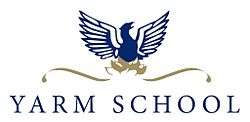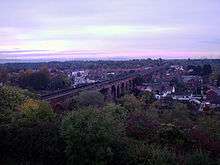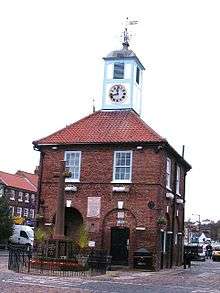Yarm School
 | ||||||||||||||||||
| Motto | Educating for Life | |||||||||||||||||
|---|---|---|---|---|---|---|---|---|---|---|---|---|---|---|---|---|---|---|
| Type | Independent school HMC | |||||||||||||||||
| Religion | Church of England | |||||||||||||||||
| Headmaster | David M. Dunn | |||||||||||||||||
| Founder | R. Neville Tate | |||||||||||||||||
| Location |
The Friarage Yarm Stockton-on-Tees TS15 9EJ England Coordinates: 54°30′24″N 1°21′07″W / 54.50670°N 1.35202°W | |||||||||||||||||
| Students | c1200 | |||||||||||||||||
| Gender | Co-educational | |||||||||||||||||
| Ages | 3–18 | |||||||||||||||||
| Colours |
| |||||||||||||||||
| Former Pupils | Old Yarumians or YOBs (Yarm Old Boys) | |||||||||||||||||
| Website | Yarm School | |||||||||||||||||
Yarm School is a co-educational independent school in the Georgian market town of Yarm, England, on the River Tees. The school educates over 1200 pupils and is a member of the Headmasters' and Headmistresses' Conference.
History
The earliest traces of the school can be dated to 1590,[1] with the formation of a Free Grammar School by Thomas Conyers, on the site of Yarm Parish Church, to provide education for the poor boys of the town. In 1799, a legacy of £400, by William Chaloner, Esq. provided for the education of eight free boys, known as Chaloner's Scholars. The school remained on this site for nearly 300 years until 1884, when the trustees purchased three acres of land on the Spital road, and erected the present commodious premises, with master's house adjoining. The buildings are in the Domestic Gothic style, and are replete with all the most modern conveniences for the benefit and comfort of the scholars and boarders.[2] These buildings housed the school until 1977, but now are home to Yarm Preparatory School.
As alluded to above, in 1977 the school was forced to close. However, in 1978, "largely due the efforts of a small group of fiercely determined parents",[3] it was reborn as an independent school for boys on the same site, under the headship of R. Neville Tate. In September 1980, the school moved to its current location at The Friarage, on the west bank of the River Tees. At the same time, Yarm Preparatory School opened, moving into the former grammar school buildings, in response to public demand for traditional preparatory school education. An Early School for boys and girls aged 4 to 6 years and a Nursery for 3 year-olds was added soon after.[4] In 2001 the school became fully co-educational; it was the first co-educational school in the local area and as a result, many schools such as Ampleforth College and Teesside High School followed suit.
In late 2006 and early 2007 plans for a relocation needed planning permission from Stockton Council. The council refused permission, at which Yarm made an appeal. In 2008 the school retracted the relocation plans. A further £20 million redevelopment plan, that included a large auditorium, was approved in 2009.[5] In 2006, the school expanded further with the acquisition of Raventhorpe Preparatory School which became the satellite feeder school Yarm at Raventhorpe.[6] However, in January 2013 it was announced that Yarm at Raventhorpe would be closed. This is because the school was no longer financially viable, however all Yarm at Raventhorpe pupils were offered places at Yarm Preparatory School.

School buildings
The school originated in the buildings which are now the Preparatory School, before moving into the current Friarage building when the older buildings became too small to accommodate the expanding pupil body. The Friarage building is a large Georgian manor house, that was built after the demolition of the Dominican Friary which had existed there from the 12th till the 16th century.[7] Some parts of the old friary still survive - for example, the oldest building in Yarm is located on the school grounds - the Dovecote was originally part of the Dominican Friarage, and was built in the 12th century to provide a source of food for the monks. It is reputed that there is a tunnel from the haunted cellar of the Friarage to the Tees, as a way for the monks to get down to the river if necessary. However, no such tunnel has been found. The current Sixth Form common rooms are in the old Friarage stable block, which was built as part of the Georgian development - the original coach archways are still visible.
In the 1990s, further expansion of the school resulted in the building of the 'Tate Building' for science and technology, named after the founding headmaster, R. Neville Tate. At the same time, the 'Hunt Building' for History, Geography and English was built, named after and opened by the former governor of the Falkland Islands, Sir Rex Hunt. In conjunction with the 'Hunt building' the school also opened a new theatre, which was opened by Lord Briggs. Since the school's expansion in 2009, this has been turned into the school refectory.
In 2009, the School was granted permission to build £20 million worth of new facilities to the schools existing site. Whilst there were wide ranging developments to the Preparatory School such as the building of new multi use sports pitches and extending the schools pre-prep facilities, the majority of investment was on the School's main site by the river. This included the development of a new dining hall and construction of new class rooms alongside the riverside. The school invited Princess Alexandra to open its new, state of the art Auditorium. The school has received national acclaim for the new development from the Royal Institute of British Architects.[8] The new development houses classrooms for English, Modern Languages and Economics.
Curriculum
The school teaches subjects towards the International General Certificate of Secondary Education and GCSE qualifications, including English and English Literature, Mathematics, Sciences (nearly all pupils study three sciences), and Languages (most pupils study French and German; Spanish is an option). Aside from compulsory subjects, students are able to study Humanities (including History, Geography and Classics etc.), Business Studies, Art and Design Technology. Some GCSEs can be studied outside of curriculum time, including General Studies and Russian.
A-levels are taken in Humanities, sciences, creative arts and social sciences[9]
In 2012 the school was listed for A-levels, as the 20th most successful independent school in the country by The Independent.[10] Most pupils from Yarm go on to study at Russell Group universities, and in 2013 17 Upper Sixth students secured places at medical and dental schools, amounting to 20% of the cohort.[11]
Sports include rowing, rugby, cricket, hockey, netball, rounders, football and canoeing; partaking in sport is compulsory.
Extra-curricular activities
Pupils participate in activity sessions such as beekeeping, horseriding, rowing, debating, stock brooking and cricket, rugby and rowing, or continue academic study in Ancient Greek, Russian or general studies.
In election years, such as 2010, the school holds a mock election, where pupils from Sixth Form politics classes acted as candidates representing the main British political parties. Similarly, in 2016, the school held a mock EU Referendum, with senior school, sixth form, and staff eligible to vote. The school voted to remain.
Pupils help to raise money for their designated house charities. These charities can be local, national or international. Each house typically raises over £2,000 per year through a variety of fundraising activities.[12]
Sport
Most of the school's sports' pitches are located off the school site; Aislaby playing fields are located on the north side of the river near the village of Aislaby, whilst Green Lane (the larger set of pitches) are located on the outskirts of Yarm. Green Lane contains rugby pitches and a 1st XI cricket pitch. There are multi-weather playing fields for hockey and tennis located on site. Tennis, rugby, cricket and hockey are played as fixtures for the boys; tennis, netball, rounders and hockey are played as fixtures for the girls.
There is emphasis on sport at Yarm; both boys and girls have a 'games' session each week in the senior school. In the Sixth Form, Mondays and Wednesdays are completely devoted to sport. Rugby and Hockey are compulsory for boys in the 1st to 3rd years, after which they continue only sports in which they show aptitude. Rowing is an option in 3rd year games, which can be continued throughout the rest of the pupil's school career.
In July 2009 a team of cyclists from the school won the over-16 category of the British Schools Cycling Association National 10 miles (16.1 km) Time Trial Championships.[13] The school has a rugby tradition, and maintains links with the 'Yarm Old Boys' rugby team. On 23 March 2013 the 1st XV won the U18 Daily Mail Vase against Felsted School 17-15 at Twickenham.[14]
The school also has a competition boat club, the Yarm School Boat Club.[15] In 2009 it won 2 of the 32 categories in the Durham Regatta,[16] and has been represented at Henley Royal Regatta.[17]
Outdoor education
The school has an outdoor education department which organises games, activities and school expeditions.
The department provides annual trips for 1st and 2nd years to the Lake District. During summer kayaking and canoeing takes place on the river. A winter option is climbing, with trips to nearby Scugdale and local indoor climbing walls. Expeditions have included those to Peru (2012) and Nepal.
The school promotes the Duke of Edinburgh's Award, with most pupils undertaking the Bronze Award, and others continuing to Silver and Gold. This year 12 UVI formers took part in the Gold DofE programme.
Combined Cadet Force
The school Cadet Force Contingent includes two sections: Army and RAF. The Army section is attached to the Yorkshire Regiment, with whom it attends regular training, using facilities at nearby Catterick Garrison.
The cadets learn military based skills such as climbing, abseiling, weapons training, orienteering and tactical assault simulation. There are a number of CCF Camps, Military Training Weekends and cadet competitions each year, during which the cadets go on field manoeuvres in order to apply the skills they have learned to a practical situation.
The cadets represent Yarm School on Armistice Day on parade in Yarm High Street, in memory of the Boer War, First World War, Second World War and the Korean War.

An Autumn term annual dinner is held for CCF staff members and cadets. Parents of cadets are invited to the dinner by the Contingent Commander. The dinner represents that of a military mess dinner.
The RAF Section attends flying days to RAF Leeming for experience in flying the Grob Tutor plane. Cadets in the RAF section also attend Gliding events at bases such as Topcliffe, and Easter camps with RAF sections from other schools.
The Contingent regularly participates in local competitions such as Colts Canter, The SAAM at Strensall and Tremlett Trophy.
The CCF go on annual camps to different military locations, most recently to Munster, Germany in 2010, Crowborough in 2011 and Episkopi, Cyprus in 2013.
Awards and recognition
According to the Good Schools Guide, the school is "cheerful and welcoming" and is a balance of the "traditions of grammar School with modern, forward-thinking attitude". School pupils received a total of 1102.2 A/AS points per pupil and 242.8 A/AS points per entry in 2010. At GCSE, in 2010 28.2% of entries were A* and 60% of GCSE entries were either A* or A's.
Houses and year groups
The school is arranged into four houses, each with its own housemaster or housemistress and tutor team. Houses have their own colours, and compete at an inter house level in sport and drama. Each house is named after prominent British saints associated with the North East of England: Aidan, Bede, Cuthbert and Oswald. There are five Senior School year groups, plus a Lower and Upper Sixth.
News
In December 2006 two old Yarumians added a graffito of a penis on the roof of the Friarage building, which was recorded by Google Earth. The graffito has since been removed.[18]
Notable Old Yarumians
Politics
- James Wharton – Conservative MP since 2010 for Stockton South and Parliamentary Under Secretary of State for Communities and Local Government since 2015.
Sport
- Ben Gibson (footballer) Middlesbrough FC
- Simon Webster – Rugby union player
- Paul Johnston – Cricketer
- Russell Earnshaw Rugby Union player
- Katherine Copeland MBE – GB rowing Olympic gold medallist
- Will Kay Rugby Union Player
References
- ↑ R. Neville Tate, A Story to be Told, Quoin Publishing Ltd., ISBN 978-1-907257-06-3
- ↑ "Yarm: Geographical and Historical information from the year 1890". Genuki. Retrieved 7 January 2012.
- ↑ R. Neville Tate, A Story to be Told, Quoin Publishing Ltd., ISBN 978-1-907257-06-3
- ↑ "Yarm School History". Yarm School. Yarm School. Retrieved 19 December 2012.
- ↑ "Plans for Yarm School redevelopment approved". Evening Gazette. Gazette Media Company Limited. 11 June 2009. Retrieved 2 June 2012.
- ↑ "Yarm School steps". The Northern Echo. Newsquest (North East) Ltd. 15 December 2006. Retrieved 2 June 2012.
- ↑ "Yarm Friary". Yarm School. BBC. Retrieved 8 November 2013.
- ↑ "Yarm School History". Yarm School. RIBA. Retrieved 5 November 2013.
- ↑ "Yarm School Sixth Form Academic Curriculum". Retrieved 19 December 2012.
- ↑ "Top 100 Independent Sixth Forms". The Independent. London: News Group Newspapers Limited. 26 January 2012. Retrieved 19 December 2012.
- ↑ "Yarm School Sixth Form Academic Success". Retrieved 8 November 2013.
- ↑ "Grassroots - Yarm and Eaglescliffe.". AccessMyLibrary: Europe Intelligence Wire. Gale (Cengage Learning). 26 March 2003. Retrieved 2 June 2012.
- ↑ Fiona (Administrator) (3 July 2009). "Joy for cycling trio after national success". Gazette Live. Gazette Media Company Limited. Retrieved 2 June 2012.
- ↑ "Yarm School wins the U18 Daily Mail Vase".
- ↑ "Yarm School BC", Britishrowing.org. Retrieved 1 May 2012
- ↑ "Durham Regatta Winners 2009" (PDF). Durham Regatta Winners 2009. Durham Regatta. 2009. Retrieved 2 June 2012.
- ↑ "YSBC beats Emmanuel School". Youtube. 5 July 2010. Retrieved 19 December 2012.
- ↑ Ben Ashford (1 August 2007). "The Piddler on the roof". The Sun. London: News Group Newspapers Limited. Retrieved 2 June 2012.